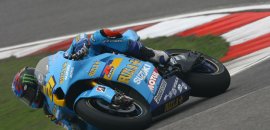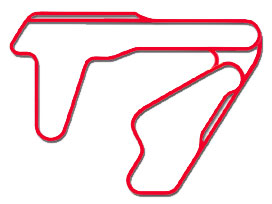Toronto Motorsports ParkFrom Trackpedia
Track SummaryWeb site: http://www.torontomotorsportspark.com/ Driving Forum: Driving Toronto Motorsports Park race track Address: 1040 Kohler Road, Cayuga Ontario 1-866-824-RACE(7223) OR (905) 772-0303 Track GuideThe circuit at Cayuga was built on the foundations of a World War II era airfield. For some time now one of the airstrips had been converted into an NHRA dragstrip whilst two additional landing strips in the triangular-shaped airfield lay unused. The track’s management has at long last repaved these strips and used them as the nucleus for a brand new multi-configuration racetrack. The longest layout, dubbed "Raceway Park," uses both strips as straight-aways with several connecting stretches of newly paved corners and short straights. A lap starts with the 0.7 km Pit Straight, long enough to wind the engine up into fourth gear, check the instruments, and pine for more horsepower. The fresh asphalt is smooth and wide, allowing the more powerful cars to make leisurely passes on the right side. The pit lane on the left is currently demarcated by cones and feeds cars onto the track halfway up the straight. I noticed that water didn’t pool up into lakes during the rainstorm but was instead clearly draining off to both sides, so it is possible to build up a surprising amount of speed here even in the wet. 1: A lot of that speed has to be bled away in preparation for Turn One, a right-hand 120 degree sweeping bend that will carry the car onto the Back Straight. Shift down to third gear just before the turn-in, which begins when one can clearly pick out the red and white apex curbing. It is very important to be looking up and through that curbing to discern where the curve tracks out as this corner is visually deceiving. The apex curbing is there for the hairpin/carousel corner forming the ‘Club’ circuit configuration. As the car sweeps past this curbing the track surface changes, likely because we are now joining a different circuit. Unfortunately this can unsettle the car as it will seem to skate sideways for a bit. Fortunately Turn One is opening up from this point and one can easily control the amount of drift with the throttle. A set of exit curbs are placed precisely at the beginning of the back straight; taken properly, the car will ease right up to these. If, due to an excessive ‘pucker factor’ earlier the car isn’t forced out to the curbs the driver becomes painfully aware of how much faster he or she could have been. I predict that Turn One will be subject to some experimentation about the amount of braking needed and the turn-in point since almost every driver feels that they left something on the table once they’re through. When the track is wet the traction difference caused by the mid-turn pavement change is accentuated, leading to even more lurid sliding. Nevertheless I found the drainage to be so good that the tires always hooked up again and allowed a steady reapplication of throttle to power the car out. The Back Straight is not as long as the Front, perhaps only 0.4 km. There is a noticeably large amount of run-off at the end where the landing strip continues; whereas on the Front Straight the end of the strip is the beginning of Turn One. Due to its shorter length I found it unnecessary to shift up into fourth, but that may depend on each car’s gearing. 2: Although it is just as wide as the Front, the Back Straight appears to be somewhat bumpier with slightly less efficient drainage. With water on the track I found the car to be noticeably more squirrelly in braking for Turn Two, so much so that the straight’s run-off area provided a welcome safety valve. Turn Two is a shallow right-hand bend that can be taken quite quickly provided one realizes that the aim is to exit at the entrance to the next turn on track left under control, able to brake sharply in a straight line and downshift to second. Excessive trail braking into Turn Two, brought on by a tendency to ‘go deeper’ in an effort to maximize speed, will result in pirouettes. At least the terrain around here is completely flat. 3: Turn Three is a tricky 120 degree right-hander that is best taken with a consciously late clipping point picked out immediately after executing the turn-in. Being under control for the turn-in is of paramount importance as any trail braking will grossly exaggerate the car’s rotation! Ideally the throttle can be fed in some time before clipping the curbing on the right so that the car barely stays on the track as the left-hand exit is approached. If the entry was screwed up it will be necessary to moderate throttle input to avoid running out of track. 4: I found my car’s second gear to be tall enough to carry through the exit and the short chute beyond to Turn Four, others may feel a shift up to third is necessary. Swing the car back to the right then apply moderate braking before swinging into the short, sharp left-handed Turn Four. This turn feeds directly into the next so that the two could be considered a chicane: the aim will be to minimize the rightward weight transfer to allow a quick transition into turning right. 5: At the apex curbing there is a slight depression that fills up with water, nevertheless this is easily avoided. Once past the apex a slight jab of brake or throttle lift is all that is needed to settle the car for an immediate swing back to the right for Turn Five, using the absolute minimum of track to the left. Turn Five is an increasing radius turn which features a slight kink at the exit onto the Training Circuit’s back straight. A cluster of pylons marked the inside point of the kink (and beginning of the straight) on track left; they are only narrowly avoided when exiting the corner at speed. Get on the throttle right away to power through this turn as enough speed is lost from entering the first part of this chicane. I found an immediate upshift to third was called for once the kink was cleared, followed by a blast down the short back straight towards the Turn Six hairpin. At this point the ‘Training’ and ‘Club’ circuits are joined so the track actually continues past the turn (6) to make a right turn onto the Back Straight for the Training Circuit, hopefully the cones closing off this turn will make the choice clear! 7: The left-handed Turn Seven hairpin (carousel) is best taken in classic fashion from track right with heavy braking to the turn-in point about level with this turn’s apex curbing. Swing the car around to the left and choose a late clipping point about < along on the inside, nail (or feed) the throttle according to preference and power out to exit track right. Do not be disconcerted by the puddles which form around the first part of the apex when raining as you ought to be considerably straightened out by the time you hit them. Most of the car’s weight will have been transferred to the right by then, allowing maximum grip for staying on the track. There are no exit curbs here, though, so once a couple of wheels come off a trip into the weeds is practically guaranteed. 8 & 9: Once onto the Back Straight shift up to third to experience a satisfying surge through the car’s maximum torque band, provided all went well with the hairpin. The end of this straightaway features a little chicane, Turns 8 and 9, although my practice was to cut a diagonal straight line through both of them whilst flat out. I noticed others were treating these kinks with more respect, perhaps to set up for a more classic approach to the sharp left-handed Turn Ten. 10: Cars which straight-line the chicane must immediately get on the brakes since Turn Ten comes up right away. The diagonal approach sends the car hurtling towards the inside apex curbing, as soon as enough speed has been discarded shift down to second, turn the car and jump back onto the throttle. This will send the car to the far right of the track on the exit, continue to swing to the left in order to set up for the Turn Eleven carousel. 11: Lots of sideways weight transfer occurs here which can help pitch the car into the correct attitude, just don’t overdo it or face the consequences! The proper entry is important for Turn Eleven as it is a decreasing radius 180 degree bend through which it is very easy to run out of track. Brake hard and stay track left during the entry until you can see the exit curbing, then pick out a clipping point on the inside that allows you to smoothly arc the car to the exit. Feed in the throttle and hopefully you’ll be able to stay on it right past the exit to upshift into third immediately after. Keeping the eyes up and forward is doubly important for this tricky turn. 12, 13, & 14: The next series of turns is a combination that leads onto the Front Straight and naturally calls for precise execution. The sweeping left-hand Turn Twelve is followed immediately by a pair of 90 degree right-handers, Turns 13 and 14, the last of which dumps the car onto the airfield straightaway. My line through these was the subject of some controversy at our lapping session: I’ll do my best to present both sides of the case so interested enthusiasts can choose for themselves. In order to maximize acceleration down the Front Straight it is necessary to begin accelerating at the point furthest back from the straight, which is the leftmost side of the track at the apex of the Turn 13 and 14 combo. My aim is to arrive at this point (call it Point Zero) under control and ready to begin acceleration out of the turn as soon as possible. Once the upshift into third coming out of Turn Eleven is done it is possible to make a smooth transition under constant acceleration from turning right to left as the car crosses the track to the right side to begin entry into Twelve. The left-hand Turn Twelve can be taken flat-out in third gear with a slightly early clipping point leaving the car pointed diagonally down the track, heading to the left of Point Zero. Heavy braking in a straight line while travelling diagonally, accompanied by a downshift into second, should be finished just as Turn Thirteen’s apex curbing is reached, although there is room to carry on further if brake fade is encountered! This line appears to be hugging the inside of Thirteen but in fact the turn is ignored altogether because the concentration now will be to turn the car to arrive at Point Zero and to begin accelerating. If misjudged it is easy to drop a wheel off the track at Point Zero as there is no curbing installed here, the prudent course especially in the wet is to simply keep braking after the exit of Twelve until the car is under control. Once at Point Zero line up the exit to Turn Fourteen somewhat past the currently installed pit wall concrete barriers, turn in and floor it. The clipping point will be approximately at the centre of Fourteen's apex curbing and the car will track out naturally to the pit wall cones. From here you have the entire Front Straight to reflect on your successes and failures and plot the next lap! An alternate approach to this last complex of turns has the aim of carrying as much momentum as possible through 13 and 14, taking them as one smooth arc until exiting onto the Front Straight. In order to achieve this smooth arc it is necessary to enter 13 wide towards track left, which itself implies a tighter line through 12 as there isn’t room to swing the car to the left if one exits 12 on the right. A tighter line through 12 means a slower line as it will be necessary to brake slightly and choose a later clipping point on turn-in instead of taking 12 flat out. The theory would be that sacrificing arrival time into 13 is more than made up for by a faster progress through 13, but I’m not convinced that’s true! I suspect we will need to await the result of empirical testing to be sure, but even then the difference may end up having more to do with the car’s characteristics than anything else. Courtesy of Christian Sorensen Local HotelsWhen visiting Toronto Motorsports Park stay at Travelodge Simcoe, the number one choice for Accommodations. For reservations call 1-800-265-8090 or (519) 426-4751 For all local accommodations: http://www.torontomotorsportspark.com/dragway/accommodations.html Trackside Camping also available Track MapSee also: http://www.bmwclub.ca/motorsport/tracks/images/caytrnum.jpg Dragway HistoryToronto Motorsports Park has been the home of drag racing in Ontario since 1955. It started as a Sunday only operation at Kohler Airstrip sharing the asphalt with airplanes. Since then the track has had many names and many changes. It is now recognized as one of the best racing facilities in North America.
|


